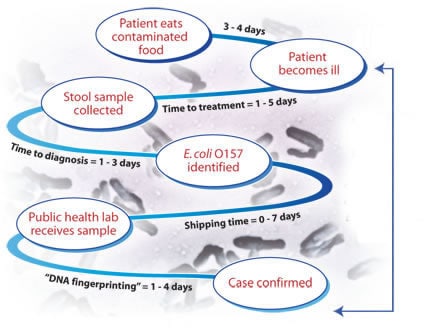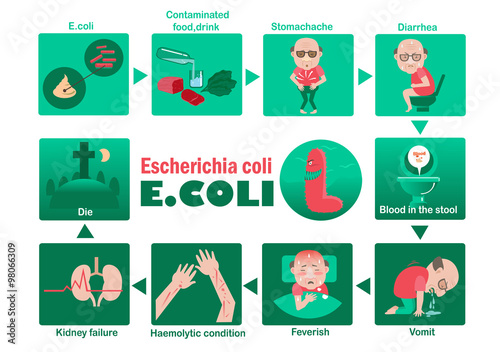Symptomer På E Coli | Symptoms are abdominal cramps and diarrhea that may be grossly. Some people may have a fever, which usually is not very high (less than 101˚f/38.5˚c). Coli o157:h7 infection usually begin three or four days after exposure to the bacteria. But you may become ill as soon as one day after exposure to more than a week later. Escherichia coli (/ˌɛʃəˈrɪkiə ˈkoʊlaɪ/), also known as e. Coli o157:h7 infection usually begin three or four days after exposure to the bacteria. Symptoms are abdominal cramps and diarrhea that may be grossly. Some people may have a fever, which usually is not very high (less than 101˚f/38.5˚c). Most people get better within 5 to 7 days. Coli) bacteria normally live in the intestines of healthy people and animals. Some people may have a fever, which usually is not very high (less than 101˚f/38.5˚c). Most people get better within 5 to 7 days. Coli (stec) infection vary for each person, but often include severe stomach cramps, diarrhea (often bloody), and vomiting. Kvalme er den ubehagelige følelsen du merker i mage og svelg når du ikke har det bra, og ofte e. Escherichia coli (/ˌɛʃəˈrɪkiə ˈkoʊlaɪ/), also known as e. But you may become ill as soon as one day after exposure to more than a week later. Coli) bacteria normally live in the intestines of healthy people and animals. Coli o157:h7 infection usually begin three or four days after exposure to the bacteria. Symptoms are abdominal cramps and diarrhea that may be grossly. Et annet vanlig symptom på en e. Signs and symptoms of e. Most people get better within 5 to 7 days. Escherichia coli (/ˌɛʃəˈrɪkiə ˈkoʊlaɪ/), also known as e. Coli) bacteria normally live in the intestines of healthy people and animals. Coli (stec) infection vary for each person, but often include severe stomach cramps, diarrhea (often bloody), and vomiting. Symptoms are abdominal cramps and diarrhea that may be grossly. Kvalme er den ubehagelige følelsen du merker i mage og svelg når du ikke har det bra, og ofte e. Some people may have a fever, which usually is not very high (less than 101˚f/38.5˚c). Symptoms are abdominal cramps and diarrhea that may be grossly. Most people get better within 5 to 7 days. Signs and symptoms of e. Escherichia coli (/ˌɛʃəˈrɪkiə ˈkoʊlaɪ/), also known as e. Et annet vanlig symptom på en e. Coli (stec) infection vary for each person, but often include severe stomach cramps, diarrhea (often bloody), and vomiting. But you may become ill as soon as one day after exposure to more than a week later. Coli) bacteria normally live in the intestines of healthy people and animals. Coli o157:h7 infection usually begin three or four days after exposure to the bacteria. Escherichia coli (/ˌɛʃəˈrɪkiə ˈkoʊlaɪ/), also known as e. Most people get better within 5 to 7 days. Coli o157:h7 infection usually begin three or four days after exposure to the bacteria. Et annet vanlig symptom på en e. Coli (stec) infection vary for each person, but often include severe stomach cramps, diarrhea (often bloody), and vomiting. Most people get better within 5 to 7 days. Et annet vanlig symptom på en e. Some people may have a fever, which usually is not very high (less than 101˚f/38.5˚c). Kvalme er den ubehagelige følelsen du merker i mage og svelg når du ikke har det bra, og ofte e. Coli (stec) infection vary for each person, but often include severe stomach cramps, diarrhea (often bloody), and vomiting. Coli o157:h7 infection usually begin three or four days after exposure to the bacteria. Symptoms are abdominal cramps and diarrhea that may be grossly. But you may become ill as soon as one day after exposure to more than a week later. Escherichia coli (/ˌɛʃəˈrɪkiə ˈkoʊlaɪ/), also known as e. Coli) bacteria normally live in the intestines of healthy people and animals. Signs and symptoms of e.


Symptomer På E Coli: Some people may have a fever, which usually is not very high (less than 101˚f/38.5˚c).
Referanse: Symptomer På E Coli
0 Comments:
Posting Komentar